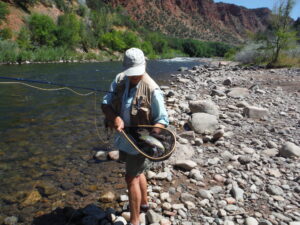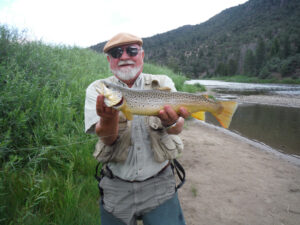 It’s been quite a while since most of us have fished dry flies so here’s a few ideas to improve your success with terrestrials this time of year. They’re bigger files than the tiny #20 midges that you see around your head while tying on another fly. Grasshoppers, beetles, ants, flying ants, all are considered terrestrial patterns that work in late summer. All show up easily with a parachute on top.
It’s been quite a while since most of us have fished dry flies so here’s a few ideas to improve your success with terrestrials this time of year. They’re bigger files than the tiny #20 midges that you see around your head while tying on another fly. Grasshoppers, beetles, ants, flying ants, all are considered terrestrial patterns that work in late summer. All show up easily with a parachute on top.
Before you get to the water, clean your fly line. It may look clean but that black stuff removed with your cleaning rag keeps it from floating high and dry. After this, and before it gets wet, put silicone on your fly. If you forgot this step and the fly is already wet, dry it off first. We keep a piece of a paper towel handy for this. Just squeeze the fly with the absorbent paper and then silicone it for a higher float. Make this standard procedure after each release. Then, put the left-over silicone left on your fingers on the area where the leader attaches to the fly line. This is the spot where most floating fly lines sink and pull the fly under water when you try to drag it across the surface.
Why does this matter? Well, most insects that fall into the water don’t go quietly to their demise. They flutter and kick trying to free themselves from the surface film. So, if you “twitch” the fly it helps it show up amongst the other inedible things floating by. We’re not talking about a long drag here, just an inch or two will suffice. Save the longer drags for the caddis patterns that entice strikes with that presentation.
Doing this little “skitter” straightens out the line and leader and helps you find the fly on the water. So, if your line isn’t floating, the fly will sink  . A little movement assures the trout that this bug is real and freshly captured in the surface film. Try it, you’ll like it!
. A little movement assures the trout that this bug is real and freshly captured in the surface film. Try it, you’ll like it!
